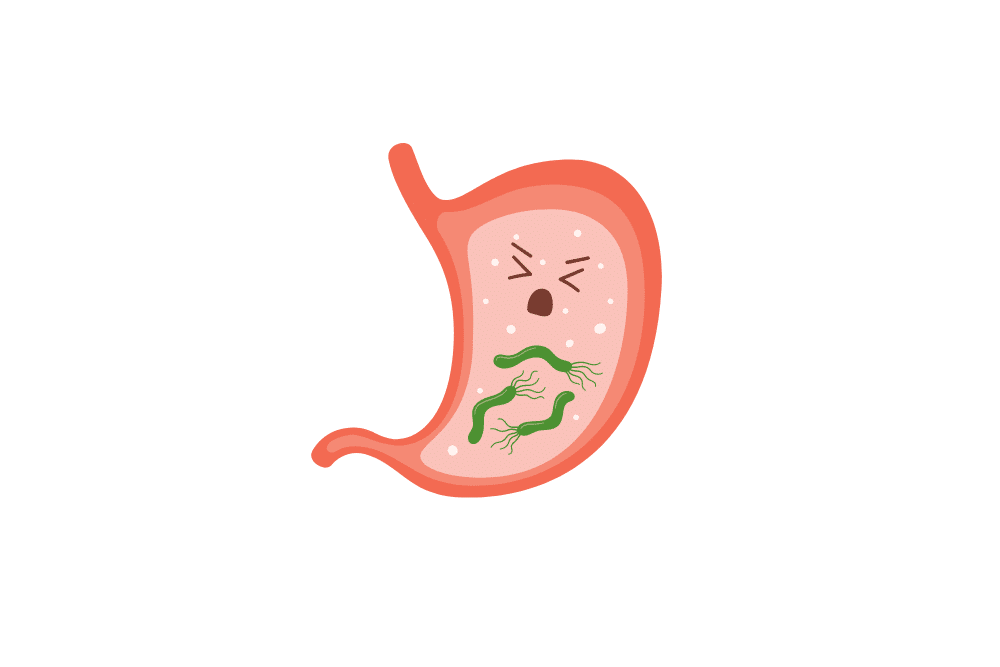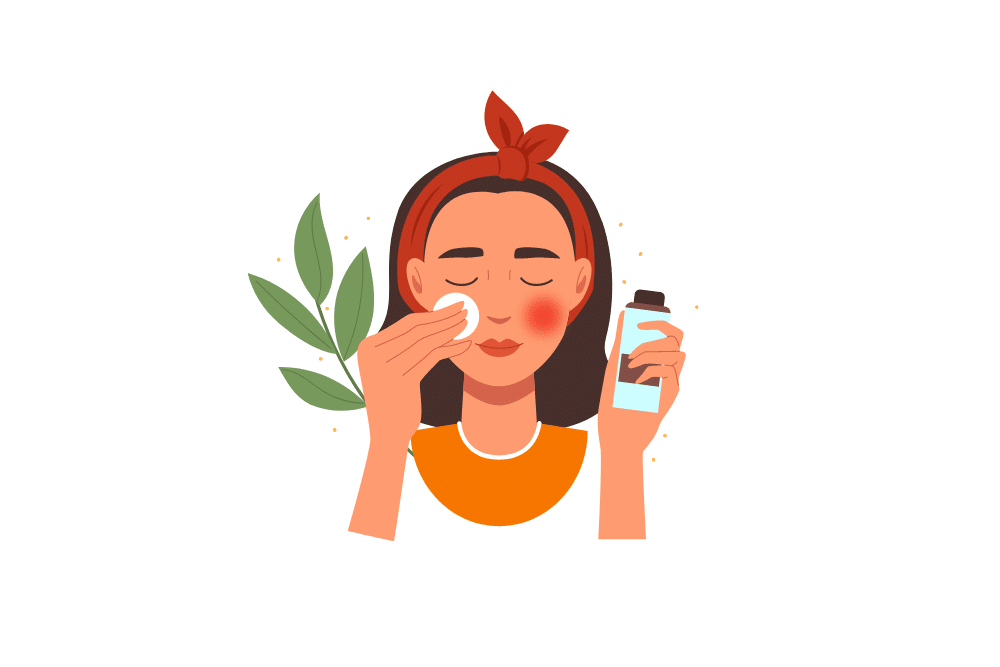To permanently get rid of rosacea, it’s essential to consult a dermatologist who can recommend a tailored treatment plan, which may include medications, lifestyle changes, and possibly laser therapy. Unfortunately, there is no guaranteed permanent cure for rosacea, but these approaches can significantly manage and reduce symptoms.
In this guide on managing rosacea, we uncover this common skin condition. If you’re dealing with persistent redness, visible blood vessels, or sensitive skin flare-ups, we’ll help you understand its causes, how to identify triggers, and effective treatments and lifestyle changes that can bring long-term relief and comfort to your skin.
Understanding Rosacea: Unravelling the Mystery of Red, Flushed Skin
If you’ve ever found yourself looking in the mirror and noticing your skin is a bit redder than usual, or if you’ve been dealing with those pesky, persistent red patches that just won’t quit, you might be dealing with rosacea. Let’s dive in and unpack what rosacea is, what causes it, and the symptoms to look out for.
What is Rosacea?
Rosacea is a chronic skin condition that mainly affects the face, characterised by episodes of flushing, persistent redness, visible blood vessels, and sometimes small, red, pus-filled bumps, somewhat resembling acne. It’s more common in fair-skinned people and usually develops in adults aged 30-50.
There are four main types of rosacea, each with its own set of symptoms:
Erythematotelangiectatic Rosacea (ETR): This type is marked by flushing and persistent redness on the central part of the face. Visible blood vessels (telangiectasia) may also be present.
Papulopustular Rosacea: Often confused with acne, this type involves redness, swelling, and acne-like breakouts that usually affect the central face.
Phymatous Rosacea: This type leads to skin thickening and a bumpy texture, often affecting the nose (a condition known as rhinophyma). It can also affect other areas like the chin, forehead, cheeks, and ears.
Ocular Rosacea: As the name suggests, ocular rosacea primarily affects the eyes. Symptoms can include red, irritated, or watery eyes and swollen eyelids. In some cases, it can lead to more serious eye problems if not treated.
Each type of rosacea may require a different approach to management and treatment. It’s important for individuals who suspect they have rosacea to consult with a healthcare professional for accurate diagnosis and appropriate treatment plans.

Causes of Rosacea
When it comes to what causes rosacea, the exact cause is still unknown, but several factors are thought to play a role:
Genetic Lottery: If your family members have rosacea, there’s a chance you might win (or lose, depending on how you look at it) the genetic jackpot and have it too.
Blood Vessel Troubles: Some experts believe that problems with the blood vessels in your face could contribute to rosacea.
Mites, But Not the Scary Kind: We all have microscopic mites called Demodex on our skin, but people with rosacea might have more of them. They’re mostly harmless, but in this case, they might be stirring up trouble.
Bacterial Factors: There’s a type of bacteria called H. pylori that’s been linked to rosacea. It’s the same bacteria that causes some stomach ulcers.
Environmental and Lifestyle Triggers: Things like sun exposure, stress, spicy food, alcohol, and even the wind can prompt rosacea flare-ups.
Rosacea Symptoms: Red Flags to Watch Out For
Now, onto the symptoms. Rosacea’s calling card is redness in the central part of your face. But it’s more than just a rosy glow. Keep an eye out for these signs of rosacea:
Persistent Facial Redness: Similar in appearance to a sunburn.
Visible Blood Vessels: Tiny blood vessels on your nose and cheeks might become visible.
Swollen Bumps: Sometimes, rosacea includes pimples that can be mistaken for acne.
Eye Trouble: Rosacea can also affect your eyes, making them irritated and appearing watery or bloodshot.
Remember, while rosacea is a chronic skin condition, its symptoms can come and go. Flare-ups might be triggered by various factors, so it’s a bit like playing detective with your own skin.
Dealing with rosacea can be frustrating, but understanding it is the first step in managing it. If you think you might have rosacea, it’s a good idea to chat with a healthcare provider or dermatologist. They can help navigate your rosacea journey with personalised advice and treatment options.

The Truth About Rosacea: Is a Permanent Cure Possible?
When it comes to rosacea, one of the most common questions is: “Can it be cured permanently?” It’s a fair question, especially if you’re dealing with those stubborn, often frustrating symptoms. Here’s the straightforward scoop: as of now, rosacea is considered a chronic condition, and there’s no known permanent cure. But don’t let that dishearten you. Understanding this aspect of rosacea is essential in setting realistic goals and finding effective ways to manage the condition.
The Chronic Nature of Rosacea
Ongoing Battle: Rosacea is known for its persistence. It’s like a long-term guest in the world of skin conditions – it tends to stick around.
Flare-Ups and Remissions: You might experience periods where symptoms are minimal or even absent, followed by flare-ups. It’s a bit of a rollercoaster.
Why There’s No Permanent Cure (Yet)
Complex Causes: The exact causes of rosacea are still not entirely understood. It’s a complex mix of genetic, environmental, and possibly microbial factors.
Research Continues: Scientists are working hard to unravel the mysteries of rosacea. Each discovery brings us closer to more effective treatments and, hopefully, a cure one day.
What This Means for You
Managing Expectations: Knowing that rosacea can’t be permanently cured (at least for now) helps in setting realistic treatment goals.
Focus on Control and Management: The aim is to control symptoms and prolong periods of remission. This approach can significantly improve quality of life.
Hope in Treatment Advances
Improving Treatments: There are more rosacea treatment options now than ever before for managing rosacea – from topical creams to laser therapy.
Personalised Care: With the help of a dermatologist, a tailored treatment plan can keep symptoms at bay and help you lead a comfortable life.
While the search for a permanent cure for rosacea continues, there’s much that can be done to manage rosacea effectively. Understanding the nature of the condition is the first step in taking control of your skin health.

Understanding Rosacea Triggers
In the quest to manage rosacea effectively, knowing what triggers your flare-ups is like having a roadmap to smoother, calmer skin. Each person with rosacea may have different triggers, but identifying and understanding these can be a game-changer in long-term rosacea management. Let’s dive into how you can pinpoint your triggers and learn ways to avoid or minimise them.
Identifying Personal Triggers
Keep a Diary: Start by keeping a rosacea diary. Note down when flare-ups occur, what you ate, your stress levels, weather conditions, and skincare products used. Patterns will soon emerge.
Common Culprits: Be aware of common triggers like hot drinks, spicy foods, alcohol, extreme temperatures, sun exposure, stress, and certain cosmetics.
Lifestyle Adjustments to Minimise Flare-Ups
Dietary Changes: If certain foods trigger your symptoms, consider modifying your diet. It’s not about strict restrictions but making informed choices.
Stress Management: Techniques like meditation, yoga, or even regular exercise can help manage stress, a known trigger for many with rosacea.
Environmental Factors
Sun Protection: UV exposure is a major trigger. Embrace broad-spectrum sunscreens and hats, and seek shade when the sun is at its peak.
Skin-Care Routines: Opt for gentle, fragrance-free skin care products. Harsh ingredients can aggravate rosacea.
The Role of Temperature
Avoid Extremes: Both hot or cold weather can trigger rosacea. Dress appropriately to protect your face from extreme temperatures.
Educating Yourself and Others
Awareness is Key: The more you understand about your triggers, the better you can manage them. Also, educating those around you can help them support your journey.
The Power of Trial and Error
Experiment Wisely: Sometimes, it’s about trial and error. Introduce new foods or products slowly and monitor how your skin reacts.
By understanding and managing your triggers, you can take significant strides in controlling rosacea. It’s not just about avoiding flare-ups; it’s about empowering yourself with knowledge and strategies to live comfortably with rosacea.

Rosacea Skin Care Routines
Navigating skincare when you have rosacea can feel like walking through a minefield — one wrong product and boom, you’re dealing with a rosacea flare-up. But fear not! Developing a rosacea skin care routine that soothes and protects your sensitive skin is totally doable. Let’s break down how you can pamper your skin with the right products and techniques, turning your skincare routine into a safe haven for your rosacea-prone skin.
The Basics of a Rosacea Skin Care Routine
Gentle Cleansing: Choose a mild, fragrance-free cleanser. Harsh soaps can strip your skin of its natural oils, leading to irritation.
Lukewarm Water: Hot water can be a trigger. Stick to lukewarm water for washing your face to keep redness at bay.
Moisturising: Your Skin’s Best Friend
Hydrate and Protect: Moisturising is essential. Look for rosacea cream products with ingredients like ceramides, hyaluronic acid, azelaic acid, and niacinamide, which hydrate and strengthen the skin barrier.
Avoid Irritants: Steer clear of alcohol, witch hazel, menthol, and eucalyptus oil in moisturisers, as they can be irritating.
The Sunscreen Mandate
Daily SPF: Sun protection is non-negotiable. Use a broad-spectrum sunscreen with an SPF of at least 30. Mineral sunscreens with zinc oxide or titanium dioxide are often well-tolerated by rosacea-prone skin.
Ingredients to Embrace and Avoid
Rosacea-Friendly Ingredients: Aloe vera, chamomile, and green tea can be soothing. Look for rosacea cream and products with anti-inflammatory properties.
Red Flags: Avoid ingredients like alcohol, camphor, fragrance, glycolic acid, lactic acid, and urea, which can irritate your skin.
Makeup for Rosacea
Mineral Makeup: If you use makeup, mineral-based products are a safe bet. They’re less likely to irritate your skin and can help cover redness.
Test First: Always do a patch test with new products to ensure they don’t trigger a flare-up.
The Importance of Consistency and Simplicity
Keep It Simple: A simple routine is often more effective. Overloading the skin with too many products can be overwhelming and trigger rosacea.
Routine is Key: Consistency in your skincare routine can help manage symptoms and improve the overall health of your skin.
Professional Guidance
Consult a Dermatologist: For personalised skincare advice, it’s always best to consult with a dermatologist. They can recommend products, like the best prescription cream for rosacea, and routines tailored to your specific rosacea needs.
Building a skincare routine when you have rosacea doesn’t have to be a daunting task. With the right approach and a little patience, you can find products that not only avoid triggering flare-ups but also help soothe and protect your skin.

Medical Treatments: What Works?
When it comes to tackling rosacea, sometimes skincare alone isn’t enough, and that’s where medical treatments come into play. There’s a variety of options available, each targeting different symptoms of rosacea. It’s important to remember that what works for one person may not work for another, so it’s all about finding the right fit for you. Let’s explore some of the most effective medical treatments for rosacea.
Topical Medications
Soothing the Skin: Certain creams and gels applied directly to the skin can help reduce redness and inflammation. These are often the first line of treatment.
Application Tips: Consistent application as per a healthcare provider’s instructions is key to seeing results.
Oral Medications
Beyond Skin Deep: Oral medications can be prescribed for more severe cases. These may target inflammation and other underlying factors of rosacea.
Course of Treatment: The duration and type of oral medication will depend on the severity of the symptoms and individual response.
Light and Laser Treatments for Rosacea
Targeting Blood Vessels: Laser treatment for rosacea can reduce visible blood vessels and redness. They work by targeting the blood vessels beneath the skin’s surface with intense pulsed light.
Sessions and Results: Multiple sessions may be required, and results can be quite effective, though they may not be immediate.
The Importance of Professional Guidance
Tailored Treatments: A dermatologist can help tailor treatments based on your specific type of rosacea, skin type, and overall health.
Monitoring and Adjusting: Regular check-ins with a healthcare provider are essential to monitor the effectiveness of treatments and make adjustments as needed.
Managing Expectations
Patience is Key: It’s important to have realistic expectations and be patient, as some rosacea treatments take time to show results.
Holistic Approach: Combining medical treatments with a proper skincare routine and lifestyle changes can yield the best results.
Navigating the world of medical treatments for rosacea might seem overwhelming, but with the right guidance and trial and error, you can find a treatment plan that works for you.

The Role of Diet and Lifestyle in Managing Rosacea
When managing rosacea, what you put on your plate and how you live day-to-day can make a big difference. It’s not just about what you apply to your skin; your diet and lifestyle choices are pivotal in controlling flare-ups and keeping your symptoms in check. Let’s explore how tweaking your diet and making mindful lifestyle changes can contribute to better managing rosacea.
Understanding the Impact of Diet
Trigger Foods: Certain foods can trigger rosacea symptoms. Common ones include spicy foods, hot drinks, and alcohol.
Anti-Inflammatory Foods: Incorporating anti-inflammatory foods like omega-3-rich fish, leafy greens, nuts, and fruits can be beneficial.
The Power of Hydration
Stay Hydrated: Adequate water intake is essential for maintaining skin health and can help manage rosacea symptoms (drinking water also helps with acne).
Lifestyle Adjustments for Rosacea
Stress Management: High-stress levels can trigger rosacea flare-ups. Activities like yoga, meditation, mindfulness, or regular walks can help manage stress.
Exercise Smartly: Exercise is important, but intense workouts can cause overheating and worsen symptoms. Opt for low-intensity activities and keep cool.
Environmental Considerations
Sun Protection: Sun exposure can aggravate rosacea. Wearing sun-protective clothing and hats and using broad-spectrum sunscreen is essential.
Cold Weather Care: Protect your face with scarves or masks to prevent flare-ups in cold weather.
Sleep and Rosacea
Quality Sleep: A good night’s sleep can work wonders. Adequate rest helps the body and skin to repair and regenerate, which is beneficial for managing rosacea.
Avoiding Irritants
Skin Care Products: Be mindful of your skincare products; avoid those with alcohol, fragrances, and other irritants.
Household Triggers: Even certain cleaning products or fabrics can irritate sensitive skin. Opt for hypoallergenic options where possible.
The Role of Alcohol and Smoking
Limit Alcohol: Alcohol is a known trigger for many. Reducing intake can help manage flare-ups.
Quit Smoking: Smoking can exacerbate rosacea symptoms. Seeking help to quit smoking can have a positive impact.
Regular Check-Ins and Adjustments
Monitor Your Condition: Monitor how dietary and lifestyle changes affect your rosacea. What works for others may not work for you, and vice versa.
Stay Flexible: Be willing to adjust your diet and lifestyle as needed. Managing rosacea is often about finding the right balance.
By embracing a holistic approach that includes both dietary and lifestyle changes, you can play a significant role in managing your rosacea. It’s about creating a supportive environment for your skin inside and out.

Advanced Therapies and Procedures
For many dealing with rosacea, standard treatments and lifestyle changes can do wonders, but sometimes, taking things a notch higher with advanced therapies and procedures is the way to go. These innovative options, like light therapy and laser treatment for rosacea, offer a more targeted approach, especially for persistent symptoms or severe cases. Let’s explore some advanced treatments and understand how they combat rosacea.
Light Therapy: Shedding Light on Rosacea
Photodynamic Therapy: This involves using a special light combined with a photosensitising agent to reduce inflammation and redness.
LED Light Therapy: Different wavelengths of light, like red and blue LED lights, are used to calm inflammation and can even reduce acne-like bumps.
Laser Therapy: A Beam of Hope
Targeting Blood Vessels: Laser therapy emits targeted beams of light that help reduce visible blood vessels and redness.
Customisable Treatments: The intensity and type of laser can be tailored to your specific needs, making it a versatile option.
Electrosurgery and Dermabrasion
Electrosurgery: This procedure involves using electric currents to remove damaged blood vessels or reshape disfigured areas in severe rosacea.
Dermabrasion: A technique that gently sands down the skin to improve its appearance, especially useful for thickened skin.
Microneedling: Beyond the Surface
Collagen Induction: Microneedling stimulates collagen production, which can help improve skin texture and appearance.
Combination Treatments: Often used with topical treatments for enhanced results.
Emerging Procedures and Research
Innovative Approaches: The medical field is constantly researching new procedures and technologies to treat rosacea more effectively.
Staying Informed: Keep in regular contact with your dermatologist to learn about the latest advancements and treatments that might be right for you.
Post-Treatment Care
Follow-Up Care: Post-procedure care is essential for optimal results and to minimise side effects.
Integrating with Other Treatments: These procedures often work best when integrated into a broader treatment plan, including topical or oral treatments and lifestyle changes.
Advanced therapies and procedures can offer new hope for those struggling with persistent or severe rosacea symptoms. They represent the cutting edge of dermatological treatments, providing more targeted and, in many cases, more effective options than traditional methods. However, it’s vital to approach these options carefully and under the guidance of a healthcare provider or dermatologist.
Developing a Long-Term Management Plan
Working with a healthcare provider or dermatologist is key to managing rosacea over the long term. They help create a plan that’s right for you, combining different treatments and lifestyle advice. This personalised approach can include advanced prescription rosacea treatments, like those offered by Youly, tailored to specifically target rosacea. Regular check-ins ensure the plan stays up-to-date with your needs, helping you keep your symptoms under control. In short, a good management plan with professional guidance can significantly improve your life with rosacea.













